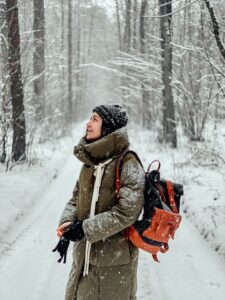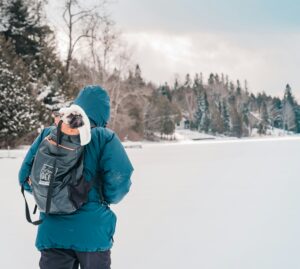How to Dress for Colorado Cold-Weather Adventures

Colorado’s mountains are stunning year-round, but winter transforms them into a wonderland of frosty peaks, snow-laden trails, and breathtaking vistas. These adventures, however, require smart preparation, especially when it comes to clothing.
Whether you’re preparing for a day out in the mountains or a winter camping trip, dressing for cold weather isn’t just about bundling up. Ditch the bulky clothes and embrace strategic layers so you can stay warm, dry, and comfortable throughout your Colorado winter activity or other expedition.
The Layering System: Your Fortress Against the Freeze
Forget the one-and-done approach. Layering is the key to regulating your body temperature and adapting to changing conditions. Think of it as building a fortress against the elements, with each layer serving a specific purpose:
- Base Layer: Your foundation. This next-to-skin layer wicks moisture away from your body, keeping you dry and preventing that clammy feeling. Opt for synthetic fabrics like merino wool or polyester, as cotton traps moisture and chills you down. Long underwear, leggings, and moisture-wicking socks are essential.
- Mid Layer: Your insulator. This layer traps heat generated by your body, creating a warm microclimate. Choose fleece jackets, puffy vests, or down jackets depending on the intensity of your activity and expected temperature. Remember, breathability is key – avoid thick, non-breathable materials that trap sweat.
- Outer Layer: Your shield. This layer protects you from wind, precipitation, and the elements. Choose a waterproof, breathable shell jacket and pants. Look for features like taped seams, pit zips for ventilation, and a helmet-compatible hood. Consider snow pants for deeper snow activities.
Pro Tip: Pack a lightweight shell layer even on mild days. Weather can change quickly in the mountains, and being prepared is key.
Material Matters: Choosing the Right Fabrics 
Not all fabrics are created equal when it comes to cold-weather adventures. Here’s a breakdown of the best fabric choices:
- Merino Wool: Nature’s wonder fiber. Merino wool is naturally wicking, odor-resistant, and even insulates when wet, making it ideal for base layers and some mid-layers.
- Synthetic Fabrics: Versatile and affordable. Polyester and nylon are common choices for base layers and mid-layers, offering good moisture-wicking and quick-drying properties.
- Down: Ultralight warmth. Down provides exceptional warmth-to-weight ratio, making it ideal for puffy jackets and vests. However, down loses its insulating ability when wet.
- Hardshell: The ultimate shield. Look for waterproof and breathable materials like Gore-Tex or eVent for your outer layer. These fabrics keep you dry while allowing moisture vapor to escape, preventing overheating.
Beyond the Layers: Essential Accessories 
Your layering system is the core, but accessories are crucial for complete comfort and protection:
- Hats: Cover your head, as a significant amount of heat escapes from there. Choose wool or fleece beanies for warmth and wind protection.
- Gloves: Keep your hands warm and dry with waterproof, insulated gloves. Consider liner gloves for added dexterity.
- Socks: Invest in good-quality wool or synthetic socks. Avoid cotton and ensure they fit snugly without restricting circulation.
- Gaiters: Keep snow and debris out of your boots with gaiters. They also add a layer of warmth and protection.
- Neckwarmer: A buff or neck gaiter is a versatile accessory that can be worn in various ways to protect your neck and face from the cold.
- Footwear: Choose insulated, waterproof boots with good traction for your chosen activity. Consider using snowshoes or crampons for deeper snow or icy conditions.
Pro Tip: Dress in layers that you can easily add or remove on the go. This allows you to adjust to changing temperatures and activity levels. 
Other things to keep in mind:
- Fit is crucial. Clothes that are too tight restrict circulation and trap sweat, while loose clothes allow cold air to enter.
- Don’t forget the sun. Even on cloudy days, the sun’s rays can be harsh at high altitudes. Use sunscreen and wear sunglasses.
- Stay hydrated. Drink plenty of water, even in cold weather, to avoid dehydration, which can worsen hypothermia risk.
- Check the forecast. Be aware of expected temperatures, wind-chill, and precipitation before heading out.
- Listen to your body. Adjust your layers and take breaks as needed to stay comfortable and avoid overheating.
With the right clothing and preparation, you can embrace the beauty and challenge of Colorado’s winter adventures. So, layer up, gear up, and get ready to conquer the chill! And after your cold weather adventure, warm up in one of Colorado’s hot springs.


